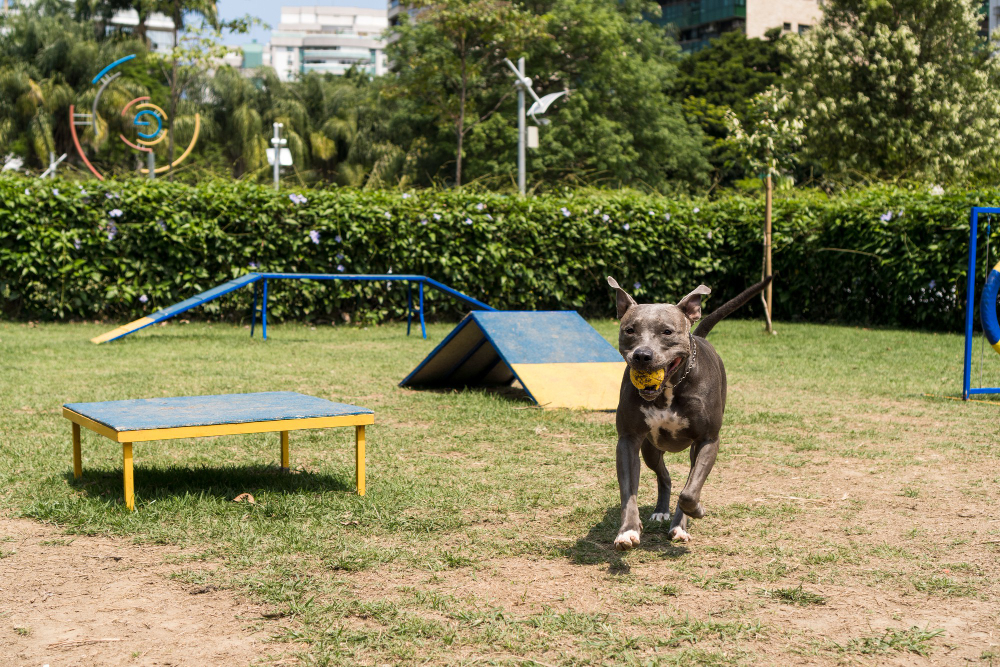The debate surrounding pit bulls dogs and their presence in dog parks is an ongoing issue. Many people have concerns about pit bull dog breeds and their safety around other dogs and humans. This article aims to explore the world of pit bulls, addressing common misconceptions, regulations, breed characteristics, and safety in dog parks.
Where Are Pit Bulls Not Allowed? Pit Bull Restrictions and Regulations
In various locations across the United States and other countries, pit bulls face restrictions and, in some cases, outright bans due to breed-specific legislation (BSL). BSL is a set of laws that target specific breeds or types of dogs, most commonly pit bulls. These laws often require pit bull owners to adhere to strict guidelines, such as muzzling their dogs in public or obtaining liability insurance. In some areas, pit bulls are entirely prohibited, leading to the seizure and euthanasia of dogs that fit the “pit bull” description.
Are Pit Bulls a Recognized Breed? Understanding Pit Bull Breed Characteristics
The term “pit bull” is often used as a catch-all phrase for a group of dogs with similar physical characteristics. However, it’s essential to clarify that there isn’t just one pit bull breed. The term “pit bull” typically refers to three main breeds: the American Pit Bull Terrier, American Staffordshire Terrier, and Staffordshire Bull Terrier. The nickname “puppy bull” is sometimes used to describe young pit bulls.
Each of these breeds showcases distinct characteristics and fascinating histories:
- American Pit Bull Terrier: This breed, often at the center of controversy, descends from the original English bulldog and terrier mixes brought to the United States in the 19th century. Known for their loyalty, strength, and intelligence, American Pit Bull Terriers were historically employed as farm dogs and protectors. While recognized by some breed registries, certain organizations do not acknowledge the breed due to its association with dogfighting and negative public perception.
- American Staffordshire Terrier: Closely related to the American Pit Bull Terrier, the American Staffordshire Terrier also traces its lineage back to the English bulldog and terrier mixes. This breed is slightly larger and heavier than its cousin, the American Pit Bull Terrier, and is known for its muscular build and confident demeanor. The American Staffordshire Terrier is recognized by most major kennel clubs, including the American Kennel Club.
- Staffordshire Bull Terrier: With its origins in England, the Staffordshire Bull Terrier is a smaller and stockier breed compared to its American counterparts. Originally bred for bull-baiting and dogfighting, the breed has evolved into a loving, affectionate family companion. The Staffordshire Bull Terrier is recognized by major breed registries and kennel clubs worldwide, including the United Kennel Club and the American Kennel Club.
Can Pit Bulls Be Around Other Dogs? Pit Bulls’ Socialization and Interaction with Other Dogs
One of the most prevalent concerns about pit bulls is whether they can safely interact with other dogs. While it’s true that some pit bulls may have dog-aggressive tendencies, it’s important to note that these behaviors are not exclusive to pit bulls and can be found in any breed. With proper socialization, training, and responsible ownership, many pit bulls can coexist peacefully with other dogs.
Experts on pit bull behavior emphasize the importance of early and ongoing socialization, exposing pit bulls to various environments, people, and animals from a young age. This exposure helps them become well-adjusted, confident dogs. It’s also crucial for owners to recognize and address any signs of dog aggression, seeking professional help if needed.
Safety in Dog Parks and Preventing Dog Attacks – Dog Attacked at Dog Park: A Focus on Pit Bulls
Incidents of a dog attacked at dog park often make headlines, with pit bulls frequently at the center of these stories. To ensure safety for all dogs and their owners, it’s crucial to follow guidelines for responsible dog ownership and behavior at dog parks.
- Only bring well-socialized and non-aggressive dogs to the park.
- Keep your dog leashed until you enter the designated off-leash area.
- Always supervise your dog, paying close attention to their body language and interactions with other dogs.
- Remove your dog from the park if they display aggressive behavior or become overly aroused.
- Respect other dog owners’ wishes and keep your dog away from dogs that may not be comfortable with your pit bull.
Additionally, dog park design and management play a crucial role in minimizing conflicts. Parks should ideally provide separate areas for large and small dogs, clear visibility for owners to monitor their dogs, and secure fencing to prevent escapes.
Can a Pit Be an Outside Dog? Pit Bulls as Outdoor Dogs
Pit bulls, like any breed, can be outside dogs, but there are some factors to consider before making this decision. While pit bulls are generally adaptable and can handle various weather conditions, they do not have thick coats, making them more susceptible to extreme cold or heat.
If you decide to keep your pit bull as an outdoor dog, provide a safe and comfortable environment, including:
- A well-insulated, waterproof, and adequately sized dog house to protect them from the elements.
- Access to fresh water at all times, preferably in a container that won’t freeze in cold weather or become too hot in the sun.
- Regular exercise, mental stimulation, and social interaction to prevent boredom and destructive behaviors.
- A secure, fenced-in yard to prevent escapes and ensure the safety of your pit bull and others.
Conclusion: Responsible Pit Bull Ownership and Advocacy
In conclusion, pit bulls are a diverse group of dogs that face unique challenges and misconceptions. While there are restrictions and regulations in place that affect pit bulls, responsible ownership and advocacy can help promote fair treatment of the breed. Pit bulls can be around other dogs and enjoy outdoor living with proper socialization, training, and care. Ultimately, fostering a better understanding of pit bulls and promoting responsible ownership can help create safer dog parks and communities for all dogs and their owners.

